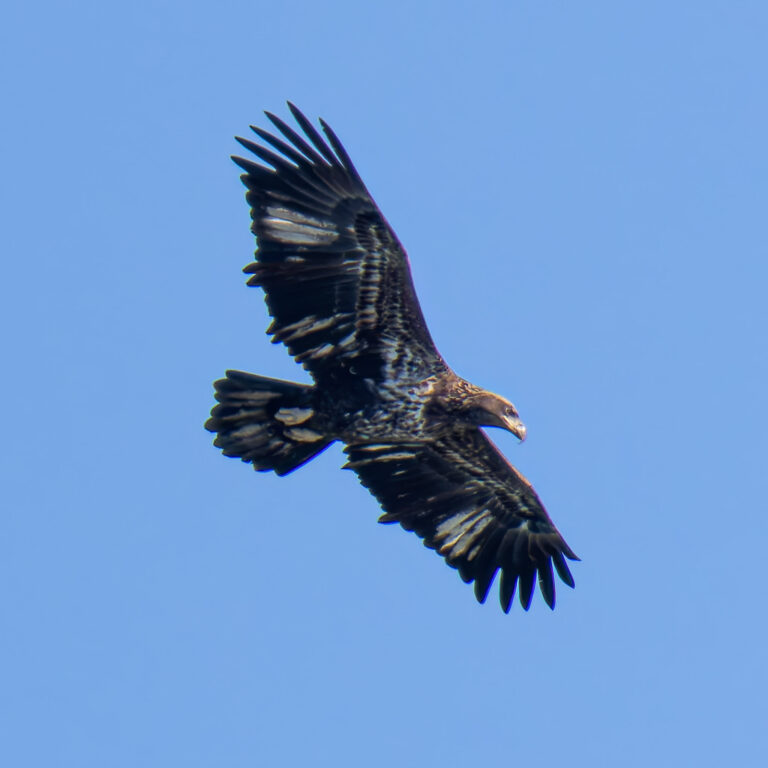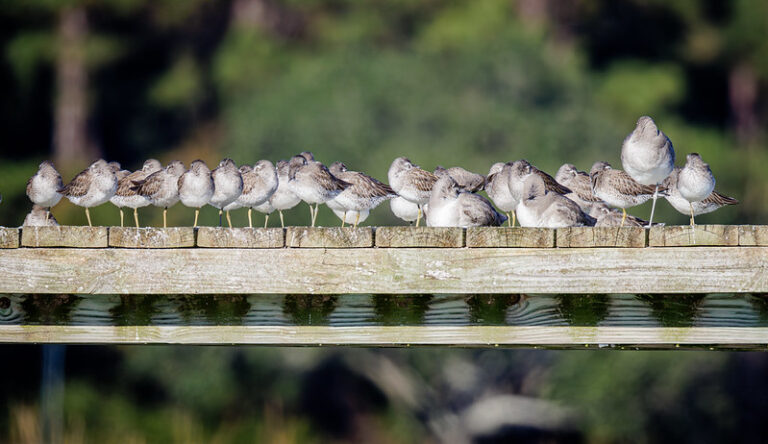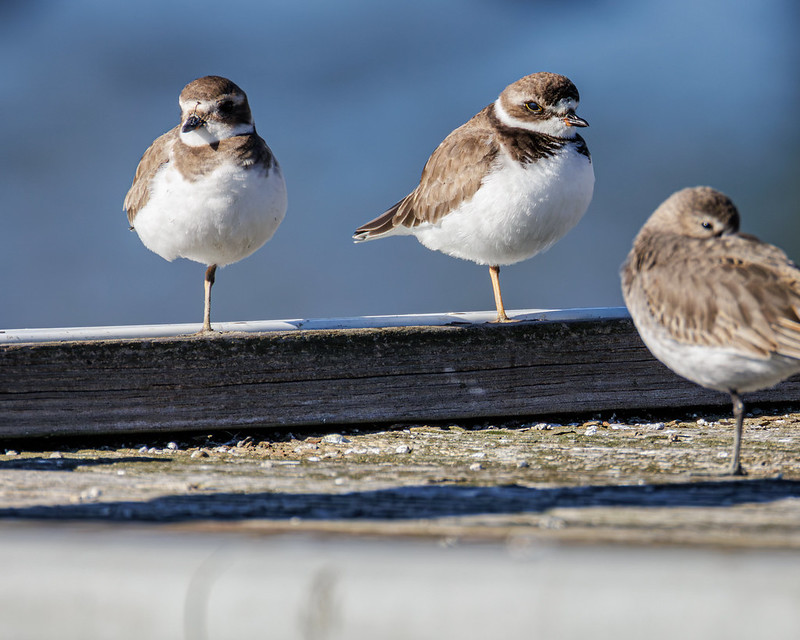As the sun set, and we waited for the evening’s celestial wonders to take place – a full moon rise and a comet’s appearance – a whistling came from the other side of the Intracoastal Waterway. The low-lying mud and shell bank was covered with American Oystercatchers, perhaps a hundred and fifty. After the moonrise, as the tide continued to flood and cover more of this bank, a third of the birds flew off and landed on a taller shell rake a little to the north. I would soon learn the significance of that pile of shells.

After my last kayak trip to Bulls Bay, and the blurry photograph of an oystercatcher with leg bands, I continued to look for the American Oystercatcher flock along the ICW. Searching with binoculars at the Romain Retreat landing, the flock did not return to that mud and shell bank, but to a shell rake a bit to the north. It was a high tide roost, a place for the birds to preen, rest, and seek protection from predators. Passing by the landing in the following week at high tide, I continued to observe the oystercatchers roosting there. A plan hatched in my mind.
I paddled my kayak on a Friday morning a few hours before the predicted high tide, taking my camera in its water bag. I scouted the identified shell rake for the best photo opportunity, choosing the small creek off the main creek cutting through the marsh to the ICW. This little waterway was protected from the wakes of the boats plying the ICW: snowbirds heading south and outboards going to Bulls Bay to shrimp. I would return to this place later.
As I paddled to the south, a small group of oystercatchers passed me, and landed ahead on a mud and shell bank. The ten birds probed as I approached slowly, circling the exposed shoal. Checking a photograph that evening, I saw one of the oystercatchers had blue bands, placed in South Carolina. The birds abruptly took off and flew to the north.


After paddling along out-of-the way creeks through the marshes, killing time prior to high tide, a group of low-flying oystercatchers passed going north, prompting my return to the high tide roost. From a distance I could see a number of birds on that shell rake, and paddled around to the backside creek. This shell rake had a steep profile, and birds were on both sides of the shell pile. My scouting paid off with excellent photographic opportunities. Later that evening, zooming in on the images, at least three birds had bands, and the different colors identified states where they were banded: Virginia, North Carolina, and New York. The codes on the bands were visible, and I was able to report these to the AMOY Working Group, participating in a bit of citizen science.

On the weekend the king tide caused by the supermoon had inundated the shell rake high tide roost I had visited on my kayak trip, but I could see to the south the flock had settled on another shell rake with a slightly higher elevation. On Monday, the flock was crammed on to the northern shell rake, though after a few minutes a few birds flew to the southern shell rake. Another fifteen minutes, and a majority of the flock took off, and passed, whistling, directly in front of me, perhaps one hundred birds. They joined the other small group on that southern shell rake, arrayed across its peak.
The moment of awe was not over. Over the marsh toward the east a dark bird of prey flew toward the roost. Suddenly the flock got up into the air, whistling and circling due to the disturbance of this northern harrier. They soon returned to the roost as the harrier or marsh hawk flew off. Will a harrier take an oystercatcher? I don’t know, but its presence definitely disturbed this flock.
A planned trip to photograph the flock from my outboard with my friend Ben, a skilled bird photographer, failed due to a dead battery. Riding to the landing on my bike to take a look before the high tide, I observed that the flock had arrived at their roost, and I returned to the landing with kayak and camera. Attempting to drift down and photograph them, I soon flushed the birds, and watched their flight to the southern shell rake. I kept track of the flock at high tide during the week, noting their fidelity to the northern shell rake.

Why did these birds intrigue me so much, and inspire me to follow them? Perhaps it was the discovery of the green bands on that Bulls Bay bird, captured in a blurry photograph. Or the night of the Hunter’s moon when I heard the chorus of whistles of the large flock across from the landing? I had seen these birds for years, but had never come to study and keenly observe them. To know another species in depth – its behavior, life history, habitats, it place in the ecosystem – is an experience of wonder, an opening into an immense world. It could be any species: black skimmer, loggerhead sea turtle, horseshoe crab, periwinkle. And now for me it was the American Oystercatcher, an iconic bird of Cape Romain National Wildlife Refuge. The refuge provides a vital winter residence for 1 out of 10 Atlantic and Gulf American Oystercatchers.
With a revised plan to start out the new week, Ben and I cruised around in my outboard, waiting for the flooding tide to create that high tide roost. A black bird taking flight off a tall shell rake at the edge of Bulls Bay came into focus as an immature bald eagle. We passed some docks providing roosting areas for a diverse group of shorebirds. The more we looked the more we stumbled on another group of birds, at rest or asleep.



We decided to anchor off the shell rake prior to the flock arriving. About forty-five minutes before high tide, I scanned to the south with binoculars, and suddenly the view field was filled with the flock approaching a few feet above the water. They passed us and the shell rake, wheeled around, and landed on the shells. What a moment of awe from our platform.
After observing and photographing the birds from our location, we hoisted the anchor and motored around to the back side of the shell rake to the small creek parting the marsh. After setting the anchor again, we continued our observations. Ben was using a long lens, and when focused on the birds he exclaimed “What just happened?” It appeared that a second wave joined the group on the shell rake, maybe doubling the flock size. The birds were arrayed on both sides of this shell ridge, and my rough count on the back side was one hundred and twenty. (Below photo gallery credit Ben Saunders)




Pulling the anchor again, we motored around to the ICW side to see the enlarged flock. With binoculars I could see some banded birds, and Ben’s photos using his telephoto lens would reveal more that evening. (In fact, Ben later identified thirty banded birds with recognizable codes on the bands. One of those birds was a re-sighting of a bird I had identified two-and-a-half weeks before, an oystercatcher originally banded in New Jersey.) Our last pass was a drift with the wind past the flock, with most of their beaks pointing into that southwest wind. We took our leave of the birds on this most satisfying afternoon.

I’ve been to Bull Island several times with my freind Ian Sanchez. What a wonderful area to observe. We go to Pawley’s island every spring for a nature week with Ian. Great fun and goods freinds!
Nature week with Ian, a can’t miss time
LOVED IT!!! and had fun trying to locate the banded AMOYs. Thanks to Ben (and you) for sharing the wonderful photos. Ginny
Really need the full resolution and zooming to see them clearly (and the ID codes). One photo in the gallery has a conspicuously banded AMOY.
Thanks for this, Bob. Beautiful! Wish I could be there with you.
BTW just returned from Tremont a couple weeks ago, took the Geology SANCP elective. Fondly recall our writers’ conference a year ago.
Thank you Bill. I envy your trip to Tremont for a Geology elective, what a fantastic institute. Looks like I wouldn’t be back to the Smokies until next fall.
I love this flock of AMOY. Found two birds this year that were at least 22 years old!!!
An incredible gathering for sure. Do you have high tide roost(s) down by Dewees and Big Hill? And 22 years – didn’t know about their longevity.
These are gorgeous photos, Ben, and what great adventures you both are having, Bob! This world of ours gives us great glimpses of awe!
This world of ours sure does.
Fun afternoon!
Really got fun at the end, didn’t it?
Thank you!
You bet
What a great adventure!
Yes, planning on more
Interesting as always – what are the birds stood on 1 leg?
In the two photographs below the eagle, the one on the right has three birds on one leg – semipalmated plovers. But the one on the left has many birds too on one leg – short-billed dowitchers.
A wonderful discovery of the awesome world!
Yes, right in our backyards.